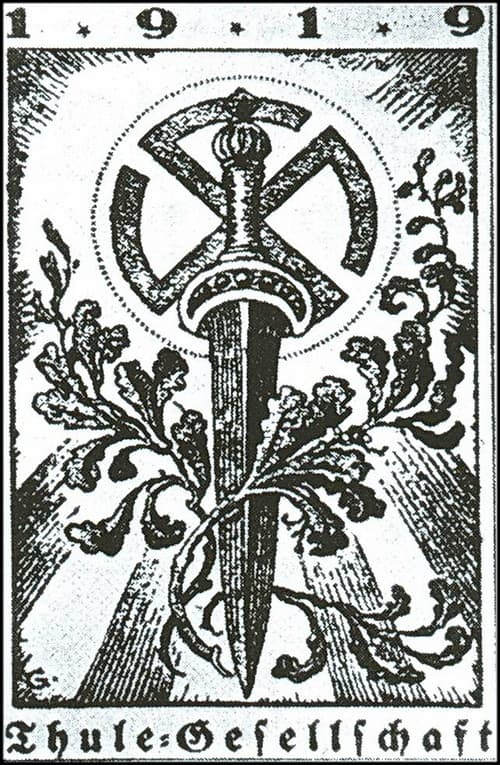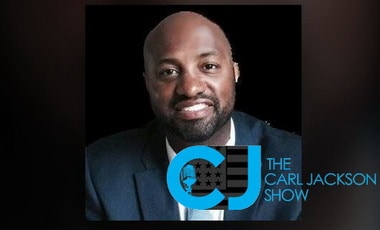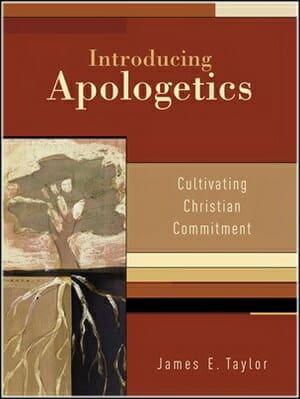(Originally posted September of 2010)
Between this post here, and a multi-part post at True Free Thinker, the reader should get all the answers available for skeptic.

This will be a critique of some points in a presentation by gay, lesbian, and transgender about homosexuality, the Bible, and Christianity. This long article attempts to pick apart some major premises of the Christian faith that many believe are a given, but would not know how to respond to it. May I also say that we as Christians should be welcoming to the gay community, while at the same time not affirming. This can be tough and should be a challenge in one’s life to show the loving kindness we have already through Christ by applying it to our cultural surroundings while not giving up the Gospel and its absoluteness. Paul was a missionary to his surroundings as we should be as well. One of the major arguments in the same sex marriage debate deals with this accepting but not affirming aspect. We want the state to accept the homosexual lifestyle by not impinging on the privacy of one’s home, but also to not affirm as a body politik this behavior by allowing marriage.
I have written on this subject a bit. I have a paper entitle Roman Epicurianism: Natural Law and Homosexuality, as well as many points of debate over the years. You can see a few of them here
- Debates About Homosexuality
- “I would never choose this lifestyle” ~ Says Gay Activist To Heterosexual
- Homosexuality: Is It Good for the Individual? Is It Good for Society?
These links are not up for debate, merely a posting of my position in regards to this topic exhumed. Okay. onto this critique of some bad thinking and application. And I truly think that ultimately this debate is not about homosexuality, but about which hermeneutic one used to interpret the Bible. This was dealt with many years ago and can be found in a free book pictured and linked to the right. 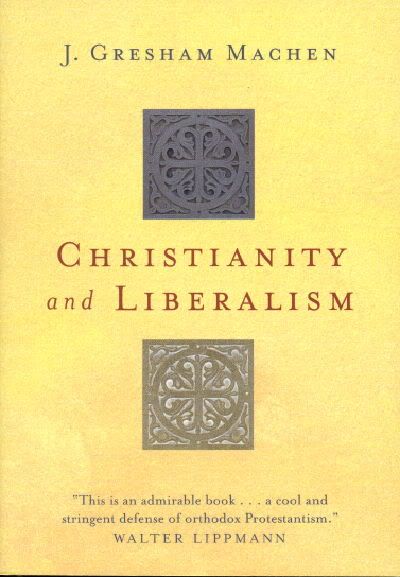 The Rev. Mel White, who happens to be the co-founder of Soulforce, wrote an article entitled “What the Bible Says – And Doesn’t Say – About Homosexuality.” (For those interested, I read Mel’s first book, Stranger at the Gate.) It is some of the points in this article I will critique and use my resources to critique as well. My first critique comes from premise number one, and is the only point I will take from this first premise. It deals with Jesus Christ and is short and sweet:
The Rev. Mel White, who happens to be the co-founder of Soulforce, wrote an article entitled “What the Bible Says – And Doesn’t Say – About Homosexuality.” (For those interested, I read Mel’s first book, Stranger at the Gate.) It is some of the points in this article I will critique and use my resources to critique as well. My first critique comes from premise number one, and is the only point I will take from this first premise. It deals with Jesus Christ and is short and sweet:
“Jesus says nothing about same-sex behavior.”
Partially true. But one can surmise from other statements and positions that God (Jesus Christ) accepts the goodness of His creation as the norm, making outright other acts inferior in form. This norm is something Soulforce stands against as the Anti-Heterosexism Meeting hints at. Where does Jesus stand on this? Let us read Matthew 19:3-6:
Some Pharisees approached Him to test Him. They asked, “Is it lawful for a man to divorce his wife on any grounds?” “Haven’t you read,” He replied, “that He who created them in the beginning made them male and female , and He also said: For this reason a man will leave his father and mother and be joined to his wife, and the two will become one flesh? So they are no longer two, but one flesh. Therefore what God has joined together, man must not separate.”
This seems pretty straight forward. Not only is Jesus affirming young earth creationism here, in contradistinction to evolutionary thought (Adam and Eve), he is also affirming a norm. A model for those reading his words to follow. Jesus like wise affirms other main aspects of “fundamentalism” that are worth listing to show the literal interpretation He had on historical events:
- Abel as the first prophet who was killed (Luke 11:50–51);
- Noah and the Flood (Matthew 24:38–39);
- Moses and the serpent in the wilderness (John 3:14);
- Moses and the manna from heaven to feed the Israelites in the wilderness (John 6:32–33, 49);
- the experiences of Lot and his wife (Luke 17:28–32);
- the judgment of Sodom and Gomorrah (Matthew 10:15);
- the miracles of Elijah (Luke 4:25–27);
- and Jonah and the big fish (Matthew 12:40– 41).
Back to the verse at hand [Matt 19:3-6]. Here Jesus is not merely mentioning a historical event that the prophets, Apostles, God, and I believe to have happened. Jesus is accessing a moral category that stems from biology. A more modern author talks about this in natural law and biological/scientific terms:
Matrimonial law has traditionally understood marriage as consummated by – and only by – the reproductive-type acts of spouses[1] whom make this biological whole. Robert George mentions a thought experiment by Professor of Christian Ethics at Mount St. Mary’s University in Emmitsburg, Maryland, Germain Grisez:
Imagine a type of bodily, rational being that reproduces, not by mating, but by some act performed by individuals. Imagine that for these same beings, however, locomotion or digestion is performed not by individuals, but only by complementary pairs that unite for this purpose. Would anybody acquainted with such beings have difficulty understanding that in respect of reproduction the organism performing the function is the individual, while in respect of locomotion or digestion, the organism performing the function is the united pair? Would anybody deny that the union effected for purposes of locomotion is an organic unity? [2]
In this short analogy, one can see that because of biology, law is fashioned to affirm one action as naturally well for society over another. Not because of bias or phobia, but because inherent in the male and female are two potential parts of a different organism, one that can reproduce naturally. What did I mean by inherent? Professor George explains:
“…take gold as an example, it has inherent in its nature intrinsic qualities that make it expensive: good conductor of electricity, rare, never tarnishes, and the like. The male and female have the potential to become a single biological organism, or single organic unit, or principle. Two essentially becoming one. The male and female, then, have inherent to their nature intrinsic qualities that two mated males or two mated females never actualize in their courtship… nor can they ever. The potential stays just that, potential, never being realized…“ (Q&A: PapaG Style)
This is what God (Jesus) was accessing… the created order and its inherent qualities that define moral categories via Natural Law. In a wonderful book, The Apologetics of Jesus, Geisler and Zukeran in their chapter on Jesus’ use of reason, quote Dallas Willard, the Professor in the School of Philosophy at the University of Southern California in Los Angeles:
We need to understand that Jesus is a thinker, that this is not a dirty word but an essential work, and that his other attributes do not preclude thought, but only insure that he is certainly the greatest thinker of the human race: “the most intelligent person who ever lived on earth.” He constantly uses the power of logical insight to enable people to come to the truth about themselves and about God from the inside of their own heart and mind. Quite certainly it also played a role in his own growth in “wisdom.”[3]
Indeed. Jesus was a thinker who accessed Natural Law, the Laws of Thought, and the like. His use of such demand our response and understanding of what He was wielding. That is point number one.
Point number two comes along lines I am very familiar to. Ad hominem attacks. I will quote the Revs second premise:
Over the centuries people who misunderstood or misinterpreted the Bible have done terrible things. The Bible has been misused to defend bloody crusades and tragic inquisitions; to support slavery, apartheid, and segregation; to persecute Jews and other non-Christian people of faith; to support Hitler’s Third Reich and the Holocaust; to oppose medical science; to condemn interracial marriage; to execute women as witches; and to support the Ku Klux Klan.
This is a lot to deal with, so I will deal with just a few, historically and logically. Logic first. Assuming that all of the above is correct in the way Mel White understands it, so what? How does this affect the veracity of the argument at hand? It would be like me quoting all the cases of homosexual violence against heterosexuals negate any argument from Mel’s side. See for instance:
(Even most of the priestly attacks were male on male.) Cataloging these crimes makes no judgment on whether or not this particular argument is Biblical or sound.[4] It has no bearing on whether there are degrees of offense to God and his created order. None. They are non-sequiturs. I could likewise quote the same exact thing and mention that this view Rev. White holds to is just like the examples I gave, a misuse of the Bible. Again, the one has nothing to do with the other, other than to engender feelings of animosity that drive the progressive to action. Rightly or wrongly. One author puts it thus:
…he [Mel White] uses a lot of anecdotal arguments about this inexcusable behavior, but that is not really a substantive argument. We could just as easily speak about the Crusades, slavery, the treatment of women, etc. None of the anecdotes deal with the heart issue, namely, what the Bible says about homosexuality. Still, it’s fine for him to use these to get an emotional appeal going before he dives into his argument.[4a]
That aside, I would love to deal with a few of the historical aspects of this point number two by the Reverend White.
- The Crusades
This is from a philosophy 101 class my son and I took at a local community college. Francis Collins, one of America’s leading scientists and head of the Genome Project for America – one of the most important scientific programs of our day, stepped outside his expertise and tried to don on a cap of a historian at times. Here is my critique of a portion of Collins book[5] for class:
b. Faith in God is harmful, since “throughout history terrible things have been done in the name of religion” (p. 39).
Another favorite of the skeptic. Here Collins drops the ball in my opinion. I will critique two aspects of his work: i. his understanding of Islam, and ii. His understanding of comparative crimes.
i. Collins is getting out of his genre a bit. If I met him I would probably hand him two books by Robert Spencer. Quickly, before I quote Spencer. Muhammad personally ordered (and partook in) the slitting of 900 throats of men, women, and children. Jesus, when Peter cut off the Roman soldiers ear, told Peter to put the sword away and healed the soldiers ear.
The nine founders among the eleven living religions in the world had characters which attracted many devoted followers during their own lifetime, and still larger numbers during the centuries of subsequent history. They were humble in certain respects, yet they were also confident of a great religious mission. Two of the nine, Mahavira and Buddha, were men so strongminded and self-reliant that, according to the records, they displayed no need of any divine help, though they both taught the inexorable cosmic law of Karma. They are not reported as having possessed any consciousness of a supreme personal deity. Yet they have been strangely deified by their followers. Indeed, they themselves have been worshipped, even with multitudinous idols.
All of the nine founders of religion, with the exception of Jesus Christ, are reported in their respective sacred scriptures as having passed through a preliminary period of uncertainty, or of searching for religious light. Confucius, late in life, confessed his own sense of shortcomings and his desire for further improvement in knowledge and character. All the founders of the non-Christian religions evinced inconsistencies in their personal character; some of them altered their practical policies under change of circumstances.
Jesus Christ alone is reported as having had a consistent God-consciousness, a consistent character himself, and a consistent program for his religion. The most remarkable and valuable aspect of the personality of Jesus Christ is the comprehensiveness and universal availability of his character, as well as its own loftiness, consistency, and sinlessness.[6]
Not to mention that just saying the Crusades were wrong is almost jeuvinile. Robert Spencer talks a bit about the lead up to Christendom finally responding — rightly at first, woefully latter.
The Third Crusade (1188-1192). This crusade was proclaimed by Pope Gregory VIII in the wake of Saladin’s capture of Jerusalem and destruction of the Crusader forces of Hattin in 1187. This venture failed to retake Jerusalem, but it did strengthen Outremer, the crusader state that stretched along the coast of the Levant.[7]
The almost Political Correct myth is that the crusades were an unprovoked attack by Europe against the Islamic world.[8] I can see with quoting Tillich and Bonhoeffer, although worthy men to quote, they are typically favorites of the religious left. Robert Schuller and Desmond Tutu on the back of the cover of Collins first edition are also dead give a ways. So PC thought is entrenched in Collins general outlook on religion and life. Continuing:
The conquest of Jerusalem in 638 stood as the beginning of centuries of Muslim aggression, and Christians in the Holy Land faced an escalating spiral of persecution. A few examples: Early in the eighth century, sixty Christian pilgrims from Amorium were crucified; around the same time, the Muslim governor of Caesarea seized a group of pilgrims from Iconium and had them all executed as spies – except for a small number who converted to Islam; and Muslims demanded money from pilgrims, threatening to ransack the Church of the Resurrection if they didn’t pay. Later in the eighth century, a Muslim ruler banned displays of the cross in Jerusalem. He also increased the anti-religious tax (jizya) that Christians had to pay and forbade Christians to engage in religious instruction to others, even their own children.
Brutal subordinations and violence became the rules of the day for Christians in the Holy Land. In 772, the caliph al-Mansur ordered the hands of Christians and Jews in Jerusalem to be stamped with a distinctive symbol. Conversions to Christianity were dealt with particularly harshly. In 789, Muslims beheaded a monk who had converted from Islam and plundered the Bethlehem monastery of Saint Theodosius, killing many more monks. Other monasteries in the region suffered the same fate. Early in the ninth century, the persecutions grew so severe that large numbers of Christians fled to Constantinople and other Christians cities. More persecutions in 923 saw additional churches destroyed, and in 937, Muslims went on a Palm Sunday rampage in Jerusalem, plundering and destroying the Church of Calvary and the Church of the Resurrection.[9]
A pastor once made mention to me that to paint a picture of the crusaders in a single year in history is like showing photos and video of Hitler hugging children and receiving flowers from them and then showing photos and video of the Allies attacking the German army. It completely forgets what Hitler and Germany had done prior.
While the church withheld the Bible from most, so the misuse of it wasn’t the case as much as a drive for political supremacy — and in fact was the catalyst for the Reformers and pre-Reformers getting copies of it into the laities hand so they could actually read what the Bible said on such matters — the response by the West’s only large organization to the Islamo-Fascism of the day was in fact a net-good. (Actually showing that God can bring good out of the bad.) This response may have been carried out wrongly at times engendering people’s fears and prejudices, however, the Bible played no role in these fears or prejudices. Mainly because the people involved in these atrocities had no access to a Bible. That aside, the totality of the Crusades [good and bad] was a net moral good for our planet and shows God’s providence over the course of history.
- Witch Trials
Here I wish to point something out that Gregory Koukl mentioned in his article, “The Real Murderers: Atheism or Christianity?” In it he points out that,
…between June and September of 1692 five men and fourteen women were eventually convicted and hanged because English law called for the death penalty for witchcraft (which, incidentally, was the same as the Old Testament). During this time there were over 150 others that were imprisoned. Things finally ended in September 1692 when Governor William Phipps dissolved the court because his wife had been accused. He said enough of this insanity. It was the colony’s leading minister, by the way, who finally ended the witch hunt in 1693 and those that remained in prison were released. The judge that was presiding over the trials publicly confessed his guilt in 1697. By the way, it’s interesting to note that this particular judge was very concerned about the plight of the American Indian and was opposed to slavery. These are views that don’t sit well with the common caricature of the radical Puritans in the witch hunt. In 1711 the colony’s legislatures made reparation to the heirs of the victims. They annulled the convictions.
A man of God ended the trials. The question then is, was this guilty judge misusing Scripture as well for his care for the Native-American and the slave as well? Or, was there issues of misapplying law in cases of religious matters? And it took a religious man to set things straight? The argument Rev. White makes is again a non-sequitur, being able to be used against his position, not to mention banal.
- Hitler’s Third Reich
This is so often misused I almost grow tired of refuting it. I can mainly supply some resources to understand some of the thinking behind the paganism found in Germany, and some of the progressive liberalism found in fascist Italy. Let us first start with a highly recommended book by Rabbi David Dalin, The Myth of Hitler’s Pope: Pope Pius XII And His Secret War Against Nazi Germany, in which, for example, the inside leaf of the book has some mind blowing points (mind blowing to the progressive):
- The true history of Pope Pius XII and the Holocaust—how the Catholic Church did more than any other religious body to save Jewish lives
- The real history of the Church and the Nazis—including the Nazi plan to kidnap the pope
- The real agenda of the myth-makers: hijacking the Holocaust to attack the very idea of the papacy—especially the papacy of the late Pope John Paul II—as well as Christianity and traditional religion as a whole
- How Hitler’s cleric, Hajj Amin al-Husseini, advised and assisted the Nazis in carrying out Hitler’s Final Solution
- How Pope Pius XII rescued Jews—and deserves to be called a “righteous gentile”—while the grand mufti of Jerusalem called for their extermination
Many times people forget that 3 million Catholics were killed in Poland. Which brings me to ask if Christianity played any role in brainwashing the youth?
We are the happy Hitler Youth;
We have no need of Christian virtue;
For Adolf Hitler is our intercessor
And our redeemer.
No priest, no evil one
Can keep us
From feeling like Hitler’s children.
Not Christ do we follow, but Horst Wessel!
Away with incense and holy water pots.
Singing we follow Hitler’s banners;
Only then are we worthy of our ancestors.
I am no Christian and no Catholic.
I go with the SA through thick and thin.
The Church can be stolen from me for all I care.
The swastika makes me happy here on earth.
Him will I follow in marching step;
Baldur Von Schirach, take me along.
~ Hitler Youth Song [10] ~
In fact, there is a plaque hung on a entrance wall to the building many people (mostly Jews) lost their lives in at Auschwitz. It quotes Hitler:
“I freed Germany from the stupid and degrading fallacies of conscience and morality…. We will train young people before whom the world will tremble. I want young people capable of violence — imperious, relentless and cruel.”[11]
Likewise, Hitler said:
“The war is going to be over. The last great task of our age will be to solve the church problem. It is only then that the nation will be wholly secure…. When I was young, my position was: Dynamite. It was only later that I understood that this sort of thing cannot be rushed. It must rot away like a gangrened member. The point that must be reached is to have the pulpits filled with none but boobs, and the congregations with none but old women. The healthy young people are with us.”[12]
So if not in the name of Christianity and in fact a rejection of the Bible… what was it done in the name of and accepting which worldview? I have some ideas on this. The first is in what name. Philosophical Naturalism, or the Neo-Darwinian Worldview. For instance, Hitler himself mentions this in Mein Kampf:
“The stronger must dominate and not mate with the weaker, which would signify the sacrifice of its own higher nature. Only the born weakling can look upon this principle as cruel, and if he does so it is merely because he is of a feebler nature and narrower mind; for if such a law [natural selection] did not direct the process of evolution then the higher development of organic life would not be conceivable at all…. If Nature does not wish that weaker individuals should mate with the stronger, she wishes even less that a superior race should intermingle with an inferior one; because in such a case all her efforts, throughout hundreds of thousands of years, to establish an evolutionary higher stage of being, may thus be rendered futile.”[13]
Hitler referred to this dispensation of nature as “quite logical.” In fact, it was so logical to the Nazis that they built concentration camps to carry out their convictions about the human race as being “nothing but the product of heredity and environment” or as the Nazis liked to say, “of blood and soil.”[14] It is significant to note that some of the Crusaders and others who used force to further their creeds in the name of God were acting in direct opposition to the teachings of Christ.[15]
Here is where the German Nazi’s diverged from what is known to be fascism as lived in Italy under Mussolini (dealt with later). I will present here some occultic ties that twisted the Super Man into the monster he became. Again, showing that this movement had nothing to do with the Bible[16]:
Many of the Nazi emblems, such as the swastika, the double lightning bolt “SS” symbol, and even the inverted triangle symbol used to identify classes of prisoners in the concentration camps, originated among homosexual occultists in Germany (some, such as the swastika, are actually quite ancient symbols which were merely revived by these homosexual groups). In 1907, Jorg Lanz Von Liebenfels (Lanz), a former Cistercian monk whom the church excommunicated because of his homosexual activities, flew the swastika flag above his castle in Austria. After his expulsion from the church, Lanz founded the Ordo Novi Templi (“Order of the New Temple”), which merged occultism with violent anti-Semitism. A 1958 study of Lanz called, “Der Mann der Hitler die Ideen gab” – or, “The Man Who Gave Hitler His Ideas” – by Austrian psychologist Wilhelm Daim, called Lanz the true “father” of National Socialism.
List, a close associate of Lanz, formed the Guido Von List Society in Vienna in 1904. The Guido Von List Society was accused of practicing a form of Hindu Tantrism, which featured sexual perversions in its rituals (the swastika is originally from India). A man named Aleister Crowley, who, according to Hitler biographer J. Sydney Jones, enjoyed “playing with black magic and little boys,” popularized this form of sexual perversion in occult circles. List was “accused of being the Aleister Crowley of Vienna”. Like Lanz, List was an occultist; he wrote several books on the magic principles of rune letters (from which he chose the “SS” symbol). In 1908, List “was unmasked as the leader of a blood brotherhood which went in for sexual perversion and substituted the swastika for the cross”. The Nazis borrowed heavily from Lis’s occult theories and research. List also formed an elitist occult priesthood called the Armanen Order, to which Hitler himself may have belonged.
The Nazi dream of an Aryan super-race was adopted from an occult group called the Thule Society, founded in 1917 by followers of Lanz and List. The occult doctrine of the Thule Society held that the survivors of an ancient and highly developed lost civilization could endow Thule initiates with esoteric powers and wisdom. The initiates would use these powers to create a new race of Aryan supermen who would eliminate all “inferior” races.
This is the first known Swastika known to be in Germany,
and it is a political poster by the occult Thule Society
Hitler dedicated his book, Mein Kampf, to Dietrich Eckart, one of the Thule Society’s inner circle and a former leading figure in the German Worker’s Party (when they met at the gay bar mentioned earlier).
“…And among them I want also to count that man, one of the best, who devoted his life to the awakening of his, our people, in his writings and his thoughts…”
After the above dedication, the notes in this edition of Mein Kampf read, “Dietrich Eckart was the spiritual founder of the National Socialist Party.” The various occult groups mentioned above were outgrowths of the Theosophical Society, whose founder, Helen Petrovna Blavatsky, was a lesbian, and whose “bishop” was a notorious pederast Charles Leadbeater. Heinrich Himmler, head of the SS, was obsessed with Freemasonry, which is full of occultic influences and practices.
The dreaded SA Brownshirts or Sturmabteilung (“Storm Troopers”, the SA) were largely the creation of another homosexual, Gerhard Rossbach.
“…the SA, under its leader Ernst Rohm, was administered to a large extent by homosexuals. And elaborate pimping service had been developed to satisfy the appetites of Rohm and his cohort…”
Rossbach, who historian Gruber says “was a open homosexual,” formed the Rossbachbund (“Rossbach Brotherhood”), a homosexual unit of the Freikorps (“Free Corps”), The Freikorps were independent inactive military reserve units, which became home to the hundreds of thousands of unemployed World War I veterans in Germany. Rossbach also formed a youth organization under the Rossbuchbund, calling it the Schilljugend (“Schill Youth”). Rossbach’s staff assistant, Lieutenant Edmund Heines, a pederast and murderer, was put in charge of the Schilljugend. The Rossbuchbund later changed its name to Storm Troopers (in honor of Wotan, the ancient German God of storms).
(See also: Was Hitler a Christian) So again the question is this: “Is Reverend White correct in connecting the Third-Reich and the Holocaust to Christianity?” The obvious answer is a resounding “NO!” One last aspect before moving on. Mussolini was a very intelligent man and even had a masters degree in philosophy and in one of his books he defined what fascism is, lets read:
“Everything I have said and done in these last years is relativism by intuition…. If relativism signifies contempt for fixed categories and men who claim to be bearers of an objective, immortal truth… then there is nothing more relativistic than fascistic attitudes and activity…. From the fact that all ideologies are of equal value, that all ideologies are mere fictions, the modern relativist infers that everybody has the right to create for himself his own ideology and to attempt to enforce it with all the energy of which he is capable.”[17]
So we can deduce from this definition given by the father of the only true fascist movement yet that it stood in direct contradistinction to Christianity. One last point before moving on to the next point. Mel documents a murder of a homosexual by a person claiming Scripture in his act. I wish not to get into said persons bad hermeneutic, exegesis, cultural and historical applications, but instead wish to bring to the attention of the reader some points of interest. Most serial killers have been either homosexual or bi-sexual. In fact, one study puts 69% of the serial killers as being homosexuals (i.e., people who were self-described homosexuals or people who had engaged in homosexual behavior immediately prior to, during, or after committing their murders).[18]
In a paper presented at the Midwestern Psychological Association in Chicago by Dr. Paul Cameron in 1983, he documented that of 518 sexually-tinged mass murders in the U.S. from 1966 to 1983, 68% of the victims were killed by homosexuals! And remember that they only make up 1% to 3% of the total population.[19]
I guarantee I would be able to find some Scriptural use or understanding in the manifesto of one of these serial killers towards their victims. Would I then discount Rev. White’s stance with this? No, it is a non-sequitur. I will bring up, however, this lopsided percentage I quoted above later; as I believe it to show something else about this topic. Mel White thinks “it’s important to hear these stories, because [he] not writing this little pamphlet as a scholarly exercise… [but as]… a matter of life and death.” Using his own thinking, I will write with this in mind. Which brings me to the next topic, his fourth premise.
Mel writes:
“organizations representing 1,500,000 American health professionals (doctors, psychiatrists, psychologists, counselors, and educators) have said clearly that homosexual orientation is as natural as heterosexual orientation, a combination of yet unknown pre-and-post-natal influences.”
This is partially true. There is good evidence that some influence comes from pre-natal influences. And there is work being done that may not only allow for the parent to catch and correct down-syndrome in the womb, but also to make sure their child is heterosexual. However, this being said, most of the homosexuals in the real world have been affected by outside influence and is correctable by counseling. And this graphic (below) Reverend White has on his site doesn’t explain how the American Psychiatric Association (APA) came to this conclusion.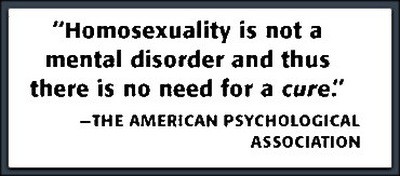
Jeffrey Satinover in his book, Homosexuality and the Politics of Truth,[20] deals with this current position and how the APA got there:
A CHANGE OF STATUS
The APA vote to normalize homosexuality was driven by politics, not science. Even sympathizers acknowledged this. Ronald Bayer was then a Fellow at the Hastings Institute in New York. He reported how in 1970 the leadership of a homosexual faction within the APA planned a “systematic effort to disrupt the annual meetings of the American Psychiatric Association” [R. Bayer, Homosexuality and American Psychiatry: The Politics of Diagnosis (New York: Basic Books, 1981), p. 102.]They defended this method of “influence” on the grounds that the APA represented “psychiatry as a social institution” rather than a scientific body or professional guild.
At the 1970 meetings, Irving Bieber, an eminent psychoanalyst and psychiatrist, was presenting a paper on “homosexuality and transsexualism.” He was abruptly challenged:
[Bieber’s] efforts to explain his position … were met with derisive laughter…. [One] protester to call him a . “I’ve read your book, Dr. Bieber, and if that book talked about black people the way it talks about homosexuals, you’d be drawn and quartered and you’d deserve it.” [102-103]
The tactics worked. Acceding to pressure, the organizers of the following APA conference in 1971 agreed to sponsor a special panel—not on homosexuality, but by homosexuals. If the panel was not approved, the program chairman had been warned, “They’re [the homosexual activists] not going to break up just one section” [104].
But the panel was not enough. Bayer continues:
Despite the agreement to allow homosexuals to conduct their own panel discussion at the 1971 convention, gay activists in Washington felt that they had to provide yet another jolt to the psychiatric profession…. Too smooth a transition… would have deprived the movement of its most important weapon—the threat of disorder…. [They] turned to a Gay Liberation Front collective in Washington to plan the May 1971 demonstration. Together with the collective [they] developed a detailed strategy for disruption, paying attention to the most intricate logistical details.[104-105]
On May 3, 1971, the protesting psychiatrists broke into a meeting of distinguished members of the profession. They grabbed the microphone and turned it over to an outside activist, who declared:
Psychiatry is the enemy incarnate. Psychiatry has waged a relentless war of extermination against us. You may take this as a declaration of war against you…. We’re rejecting you all as our owners.[105-106]
No one raised an objection. The activists then secured an appearance before the APA’s Committee on Nomenclature. Its chairman allowed that perhaps homosexual behavior was not a sign of psychiatric disorder, and that the Diagnostic and Statistical Manual (DSM) should probably therefore reflect this new understanding.
When the committee met formally to consider the issue in 1973 the outcome had already been arranged behind closed doors. No new data was introduced, and objectors were given only fifteen minutes to present a rebuttal that summarized seventy years of psychiatric and psychoanalytic opinion. When the committee voted as planned, a few voices formally appealed to the membership at large, which can overrule committee decisions even on “scientific” matters.
The activists responded swiftly and effectively. They drafted a letter and sent it to the over thirty thousand members of the APA, urging them “to vote to retain the nomenclature change” [145]. How could the activists afford such a mailing? They purchased the APA membership mailing list after the National Gay Task Force (NGTF) sent out a fund-raising appeal to their membership.
Bayer comments:
Though the NGTF played a central role in this effort, a decision was made not to indicate on the letter that it was written, at least in part, by the Gay Task Force, nor to reveal that its distribution was funded by contributions the Task Force had raised. Indeed, the letter gave every indication of having been conceived and mailed by those [psychiatrists] who [originally] signed it. . . . Though each signer publicly denied any role in the dissimulation, at least one signer had warned privately that to acknowledge the organizational role of the gay community would have been the “kiss of death.”
There is no question however about the extent to which the officers of the APA were aware of both the letter’s origins and the mechanics of its distribution. They, as well as the National Gay Task Force, understood the letter as performing a vital role in the effort to turn back the challenge.[146]
Because a majority of the APA members who responded voted to support the change in the classification of homosexuality, the decision of the Board of Trustees was allowed to stand. But in fact only one-third of the membership did respond. (Four years later the journal Medical Aspects of Human Sexuality reported on a survey it conducted. The survey showed that 69 percent of psychiatrists disagreed with the vote and still considered homosexuality a disorder.) Bayer remarks:
The result was not a conclusion based upon an approximation of the scientific truth as dictated by reason, but was instead an action demanded by the ideological temper of the times. [3-4]
Two years later the American Psychological Association—the professional psychology guild that is three times larger than the APA—voted to follow suit.
How much the 1973 APA decision was motivated by politics is only becoming clear even now While attending a conference in England in 1994, I met a man who told me an account that he had told no one else. He had been in the gay life for years but had left the lifestyle. He recounted how after the 1973 APA decision he and his lover, along with a certain very highly placed officer of the APA Board of Trustees and his lover, all sat around the officer’s apartment celebrating their victory. For among the gay activists placed high in the APA who maneuvered to ensure a victory was this man—suborning from the top what was presented to both the membership and the public as a disinterested search for truth.
So this graphic by the Reverend White means nothing. Most women I know who are lesbians who have intimated family members of mine their past have all said they were abused by a man in the family. Likewise, the two homosexual men I know well enough to ask, both had a sexual encounter with an older man when they were 14 years old and younger. Lesbian author Tammy Bruce intimates this story in her book:
… and now all manner of sexual perversion enjoys the protection and support of once what was a legitimate civil-rights effort for decent people. The real slippery slope has been the one leading into the Left’s moral vacuum. It is a singular attitude that prohibits any judgment about obvious moral decay because of the paranoid belief that judgment of any sort would destroy the gay lifestyle, whatever that is…. Here come[s] the elephant again: Almost without exception, the gay men I know (and that’s too many to count) have a story of some kind of sexual trauma or abuse in their childhood — molestation by a parent or an authority figure, or seduction as an adolescent at the hands of an adult. The gay community must face the truth and see sexual molestation of an adolescent for the abuse it is, instead of the ‘coming-of-age’ experience many [gays] regard it as being. Until then, the Gay Elite will continue to promote a culture of alcohol and drug abuse, sexual promiscuity, and suicide by AIDS.[21]
Do you think… I am asking you… do you think this is psychological in nature? I mean, raping of boys and these boys growing into men confused, hurt, traumatized (often by a close family confidant) and expressing this confusion in unhealthy lifestyle choices? These men and women are hurting and need counseling, compassion, care, and understanding. But the best way to get this to them is not to normalize the actions done to them and they do to themselves. One author mentions the timing this “reclassification came about:
…it may be just a coincidence that just about at the height of the “sexual revolution” (or devolution) the “evidence from science” changed. Keep in mind that psychiatry and psychology are soft sciences and that secular counseling and education is largely based on the societal trends de jour.[22]
Which brings me to a point I left off with in premise four. Homosexuals make up one to three percent of the population, yet, almost 70% of serial killers are homosexuals… this non-diagnosis in lieu of political correctness and the sexual revolution seems a bit quick and non-scientific, considering the abuse that leads to this lifestyle and crime stemming from this lifestyle.
In Mel’s fifth premise, you will find this:
“all kinds of relationships that don’t lead to having children:
couples who are unable to have children
couples who are too old to have children
couples who choose not to have children
people who are single”
Are these relationships (or lack of relationships) “unnatural”? There’s nothing said here that condemns or approves the love that people of the same sex have for each other, including the love I have for my partner, Gary.
In this Mr. White is saying that acts by these categories are just like acts by homosexuals. However, there is no potential in same-sex couples acts like we understand marital acts. That apparent conundrum offered by Mel has nothing on Professor Robert George’s understanding of the situation and the logical end of these acts:
ONE
Properly understood in light of a non-dualistic account of the human person, the goodness of marriage and marital intercourse simply cannot be reduced to the status of a mere means to pleasure, feelings of closeness, or any other extrinsic goal. Indeed, it cannot legitimately be treated (as some Christians have, admittedly, sought to treat it) as a mere means to procreation, though children are among the central purposes of marriage and help to specify its meaning as a moral reality even for married couples who cannot have children.
So marital acts realize the unity of marriage, which includes the coming to be of children. In consensual nonmarital sex acts, then, people damage this unity, the integrity of the marriage, inasmuch as the body is part of the personal reality of the human being and no mere sub-personal instrument to be used and disposed of to satisfy the subjective wants of the conscious and desiring part of the “self.”
The psychosomatic integrity of the person is another of the basic or intrinsic goods of the human person. This integrity is disrupted in any sexual act that lacks the common good of marriage as its central specifying point. Where sex is sought purely for pleasure, or as a means of inducing feelings of emotional closeness, or for some other extrinsic end, the body is treated as a sub-personal, purely instrumental, reality. This existential separation of the body and the conscious and desiring part of the self serves literally to dis-integrate the person. It takes the person apart, disrupting the good of acting as the dynamically unified being one truly is.[23]
TWO
(1) Marriage, considered not as a mere legal convention, but, rather, as a two-in-one-flesh communion of persons that is consummated and actualized by sexual acts of the reproductive type, is an intrinsic . . . human good; as such, marriage provides a non-instrumental reason for spouses, whether or not they are capable of conceiving children in their acts of genital union, to perform such acts.
(2) In choosing to perform non-marital orgasmic acts, including sodomitical acts—irrespective of whether the persons performing such acts are of the same or opposite sexes (and even if those persons are validly married to each other)—persons necessarily treat their bodies and those of their sexual partners (if any) as means or instruments in ways that damage their personal (and interpersonal) integrity; thus, regard for the basic human good of integrity provides a conclusive moral reason not to engage in sodomitical and other non-marital sex acts.[24]
THREE
It is sometimes thought that defenders of traditional marriage law deny the possibility of something whose possibility critics of the law affirm. “Love” these critics say “makes a family” And it is committed love that justifies homosexual sex as much as it justifies
heterosexual sex. If marriage is the proper, or best, context for sexual love, the argument goes, then marriage should be made available to loving, committed same-sex as well as opposite-sex partners on terms of strict equality. To think otherwise is to suppose that same-sex partners cannot really love each other, or love each other in a committed way, or that the orgasmic “sexual expression” of their love is somehow inferior to the orgasmic “sexual expression” of couples who “arrange the plumbing differently.”
In fact, however, at the bottom of the debate is a possibility that defenders of traditional marriage law affirm and its critics deny, namely, the possibility of marriage as a one-flesh communion of persons. The denial of this possibility is central to any argument designed to show that the moral judgment at the heart of the traditional understanding of marriage as inherently heterosexual is unreasonable, unsound, or untrue. If reproductive-type acts in fact unite spouses interpersonally, as traditional sexual morality and marriage law suppose, then such acts differ fundamentally in meaning, value, and significance from the only types of sexual acts that can be performed by same-sex partners.
Liberal sexual morality which denies that marriage is inherently heterosexual necessarily supposes that the value of sex must be instrumental either to procreation or pleasure. considered, in turn, as an end-in-itself or as a means of expressing affection, tender feelings, etc. Thus, proponents of the liberal view suppose that homosexual sex acts are indistinguishable from heterosexual acts whenever the motivation for such acts is something other than procreation. The sexual act of homosexual partners, that is to say, are indistinguishable in motivation, meaning, value, and significance from the marital acts of spouses who know that at least one spouse is temporarily or permanently infertile. Thus, the liberal argument goes, traditional matrimonial law is guilty of unfairness in treating sterile heterosexuals as capable of marrying while treating homosexual partners as ineligible to marry.
….it is a central tenet of the traditional view that the value (and point) of sex is the intrinsic good of marriage itself which is actualized in sexual acts which unite spouses biologically and, thus, interpersonally. The traditional view rejects the instrumentalization of sex (and, thus, of the bodies of sexual partners) to any extrinsic end. This does not mean that procreation and pleasure are not rightly sought in marital acts; it means merely that they are rightly sought when they are integrated with the basic good and justifying point of marital sex, namely, the one-flesh union of marriage itself.
It is necessary, therefore, for critics of traditional matrimonial law to argue that the apparent one-flesh unity that distinguishes marital acts from sodomitical acts is illusory, and, thus, that the apparent bodily communion of spouses in reproductive-type acts—which, according to the traditional view, form the biological matrix of their marital relationship is not really possible.[25]
I will import a critique by someone I consider a friend. He has an excellent series of posts dealing with this same article I am. I will let him comment a bit on Reverend White’s misuse of Genesis:
While appealing to Genesis ch. 1 and 2 Rev. Dr. Mel White only quotes five words, “In the beginning” and “it’s good.” This, of course, offers no context whatsoever. Yet, he concludes,
“We can also learn from this story that ultimately God is our Creator, that God shaped us, and said, ‘It’s good.’ Isn’t this the heart of the text?”
God proclaimed His creations “good” and the entirety of His creation “very good” while it was in the un-fallen state in which He had created all things-this is the heart of the text.
Now, let us consider an extremely important aspect of the story of creation as regards our discussion of human sexuality.
“And the Lord God said, It is not good that the man should be alone. I will make a helper suitable for him. And out of the ground the Lord God formed every animal of the field and every fowl of the air, and brought them to Adam to see what he would call them. And whatever Adam called each living creature, that was its name. And Adam gave names to all the cattle, and to the birds of the air, and to every animal of the field. But there was not found a suitable helper for Adam. And the Lord God caused a deep sleep to fall on Adam, and he slept. And He took one of his ribs, and closed up the flesh underneath. And the Lord God made the rib (which He had taken from the man) into a woman. And He brought her to the man. And Adam said, This is now bone of my bones and flesh of my flesh. She shall be called Woman because she was taken out of man. Therefore shall a man leave his father and his mother, and shall cleave to his wife and they shall be one flesh. And they were both naked, the man and his wife; and they were not ashamed” (Genesis 2:18-25).
Notice the intermixing of a discussion of Adam being alone and that of animals being brought before Adam to be named. What were the names Adam gave the animals? What language did he speak? Can etymology disclose these original names? As interesting as these questions may be they are neither as relevant nor as important as what the text is relating to us. What is the text relating?
Firstly, note that Adam’s being alone was described as “not good” and that the solution is to make “a helper suitable for him.” At this point we do not know what or whom (or what gender) this helper will be. Adam then witnesses all of the animals and yet, “there was not found a suitable helper for Adam.” Next the Lord created Eve and brought her to Adam who said, “This is now bone of my bones and flesh of my flesh.” Understand the picture and Adam’s astonished excitement. He has just seen every sort of living being and has apparently noticed that they are not like him, “This one has wings-I don’t, this one has a trunk-I don’t, this one has a tail-I don’t,” we may imagine Adam thinking. But when he sees Eve he makes a statement that expresses his acknowledgment of her as being like him, “bone of my bones and flesh of my flesh”-the perfect match for a lonely man, the companion, the helper, is a woman.
What Rev. Dr. Mel White did not point out is that the creation story has been viewed for millennia as the model for marriage. This is why “a man leave his father and his mother, and shall cleave to his wife and they shall be one flesh” (Genesis 2:18-25). One man and one woman leaving their families in order to come together for life. Keep in mind that Adam and Eve did not have human parents, which is an indication that this is meant to be a model for future generations.[26]
In dealing with these Scriptures and positions the Reverend takes, I would read forward from the link provided in footnote number twenty-six. Ken Ammi is a Messianic Jew who has an excellent grasp of the Old Testament and the created order.
I wish to end this long post by dealing with White’s (and the progressive’s) understanding of equality. In other articles the Reverend White pushes the idea that we all should be treated equal. The progressive left envisions an egalitarian society. The left values equality above other values. You cannot have equality AND liberty at the same time. You must choose one or the other.
[THERE WAS A VIDEO HERE… BUT IT IS LONG GONE IN THE ETHER OF YOUTUBE]
Prager:
Societies that did not place boundaries around sexuality were stymied in their development. The subsequent dominance of the Western world can largely be attributed to the sexual revolution initiated by Judaism and later carried forward by Christianity. This revolution consisted of forcing the sexual genie into the marital bottle. It ensured that sex no longer dominated society, heightened male-female love and sexuality (and thereby almost alone created the possibility of love and eroticism within marriage), and began the arduous task of elevating the status of women.[27]
FOOTNOTES
[1] Robert P. George, The Clash Of Orthodoxies: Law, Religion, and Morality in Crisis (Wilmington: ISI Books, 2001), 79. This is from my online chapter, Roman Epicurean’ism: Natural Law and Homosexuality.
[2] Ibid., 344.
[3] Dallas Willard, “Jesus the Logician,” Christian Scholars Review (summer 1999): 610; taken from Norman Geisler and Patrick Zukeran, The Apologetics of Jesus: A Caring Approach to Dealing With Doubters (Grand Rapids, MI: Baker Books, 2009), 66.
[4] This is a tactic used often by the left. See my recent debate entitled “Discussing Mosques and Men,” especially point number two.
[4a] Daniel B. Wallace, Review of Mel White’s “What the Bible Says — and Doesn’t Say — about Homosexuality”
[5] Francis S. Collins, The Language of God: A Scientist Presents Evidence for Belief (New York, NY: Free Press, 2006).
[6] Robert Hume, The World’s Living Religions (New York, NY: Charles Scribner’s Sons, 1959), 285-286.
[7] Robert Spencer, The Politically Correct Guide to Islam and the Crusades (Washington, DC: Regnery Publishing, 2005), 147-148.
[8] Ibid., 122.
[9] Ibid., 122-123.
[10] Gene Edward Veith, Modern Fascism: Liquidating the Judeo-Christian Worldview (Saint Louis, MO: Concordia Publishing House, 1993), 67; See Ernst Christian Helmreich, The German Churches Under Hitler: Background, Struggle, and Epilogue (Detroit, MI: Wayne State University Press, 1979), 267; Horst Wessel was the composer of the party anthem. Baldur von Schirach was the Reich Youth Leader – See Hermann Glaser, The Cultural Roots of National Socialism (Austin, TX: University Texas Press, 1978), 43, 56n.
[11] Ravi Zacharias, Can Man Live Without God (Nashville, TN: W Publishing, 1994), 23.
[12] From Hitler’s Tabletalk (December 1941); quoted in the Joachim Remake ed., The Nazi Years: A Documentary History (Lon Grove, IL: Waveland Press, 1990), 105.
[13] Adolf Hitler, Mein Kampf, translator/annotator, James Murphy (New York: Hurst and Blackett, 1942), 161-162.
[14] “The SS Blood and Soul,” one of four videos in a video series entitled, The Occult History of the Third Reich (St. Lauret, Quebec: Madacy Entertainment Group, 1998); Now in DVD – ISBN: 0974319465).
[15] For a thorough view on this topic, see my Racism and Evolutionary Thought.
[16] For full referencing see, Homosexuality, Pederasty, & Occultism’s Combined Influence On the Third Reich, this section begins on page 3.
[17] Mussolini, Diuturna pp. 374-77; quoted in A Refutation of Moral Relativism: Interviews with an Absolutist (Ignatius Press; 1999), by Peter Kreeft, p. 18. Read more: RPT What “Is” Fascism (Two Posts Combined & Imported from Old Blog)
[19] Don Boys, Ph.D., Most Mass Killers Have Been Homosexual!
[20] (Grand Rapids, MI: Baker Books, 1996), 32-35.
[21] Tammy Bruce, The Death of Right and Wrong: Exposing the Left’s Assault on Our Culture and Values (Roseville: Prima, 2003), 90,99.
[22] Ken Ammi, Rev. Dr. Mel White on Christian Homosexuality, part 3 of 21
[23] Robert P. George, A Clash of Orthodoxies, 1999 First Things 95 (August/September 1999)..
[24] Robert P. George, In Defense of Natural Law (New York, NY: Oxford Universit Press, 1999), 115.
[25] Robert P. George, The Clash of Orthodoxies: Law, Religion, and Morality in Crisis (Wilmington, DE: ISI books, 2001), 80-82.
[26] Ken Ammi, Rev. Dr. Mel White on Christian Homosexuality, part 5 of 21
[27] Democracy Forums, Why Judaism Rejected Homosexuality.

